By chance, a journal on the beauty and devastation wrought by global warming evolved from notes on art and belief, graffiti, and collage. Out of that combination emerges the eery beauty of climate change.
Don't wanna be here? Send us removal request.
Text
Beauty of Climate Change #37: Contendedness (Lichens are the Way)
Lichens are a radically different life form from mammals, or insects.

Lichens are a symbiosis or colony of fungus and algae.
The documentary film Lichens are the Way (2024) opens up the possibility of living in concert with other beings. Lichens are "the symbiotic outcome of interspecies relationships." Algae create food through photosynthesis and fungus protects algae from drying out.
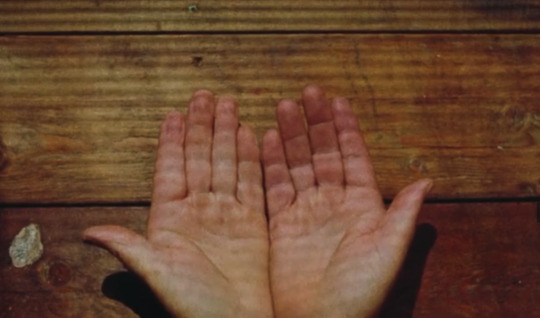
The shape of lichen's bodies dictated the plot, said Ondřej Vavrečka. His documentary film, 43 minutes long, moves at the pace of lichens.

Lichens are self-sufficient, co-habiting, or living in colonies where they benefit one another, in symbiosis. There are 22,000 species of lichens, and they have survived hundreds of millions of years. They do not (have not) progressed. These life forms do not extract or discard each other. They feed each other, rather than feed on others. Lichens, in this way, model another way to tell a story. They offer a way to rethink growth, value, and contentment.
Ondřej introduced his film at the Czech Center in New York in May 2025, after the North American premiere in Toronto. The lichens are the main characters. The supporting actors, Trevor Goward and Curtis Randall Bjorn, are experts on these plant forms who live in remote wilderness in Canada. The biologists advised the director Ondřej to arrive ten days before his film crew started filming. And be advised, we do not wear clothes.
In Lichens are the Way, we look at lichens, and they look back. The story is told from the point of view of these hybrid beings. It dissolves the boundary between subject and object, neither wanting more, nor taking, so we situates the story elsewhere.
May 21, 2025 in New York, NY
0 notes
Text
Green Blooms: The Beauty of Climate Change #36
I am hooked on murder mystery. Who has written a thriller on algae?
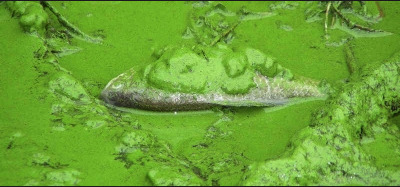
Algae bloom and dead fish, May 2007. Photographer unknown.
The novel Don't Cry, Tai Lake (2012) is a whodunnit set against a backdrop of blue-green algae. The seventh in the series of Inspector Chen novels by Qiu Xiaolong finds him on holiday at Lake Tai, known for its ethereal beauty. He finds the lake covered in green muck caused by polluting factories. His vacation turns to work when the murder of the director of one of those factories is linked to a local environmental group. The Inspector Chen mysteries, written in English, are softboiled detective writing at their best.
In May 2007, the waterworks of Wuxi were choked by green slime and left 2 million people without drinking water for one week. The episode made Wuxi the poster child for the environmental consequences of China's rapid economic growth, as Richard Stone writes.
The government seeded rain to dilute the nasty blue-green algae, and dredged 6000 tons of algae from the lake when the growth reached disastrous proportions.
(Reportedly, rotting algae smells like rotting fish.)
The cyanobacterium, Microcystis aeruginosa, produces toxins that can damage the liver, intestines, and nervous system. Natural rain fall can keep the algae at bay, but the humid heat of Wuxi, in eastern Jiangsu Province, encourages new Microcystis to grow.
The project to remove sources of nitrogen and phosphorus that fuel cyanobacterium is ongoing. The State has relocated hundreds of small chemical and manufacturing plants to close or relocate. They have also situated sewage treatment plants on tributaries of Lake Tai and is dredging the mouths of the tributaries, in order to remove nutrient-rich sediments.
The project is a looking glass for other lakes, according to marine biologist Hans Paerl, an expert in cyanobacteria who joined a team to find ways to rein in the pea-green algae. Lake Tai is China's third largest lake and irrigates food crops and cotton. Honing solutions to the algae in Lake Tai can divert disasters elsewhere. In the United States alone, algal blooms are a serious threat to drinking water and to large freshwater ecosystems. Cyanobacteria cause 2 billion USD of damage a year in losses from water unfit for recreation, drinking, and agriculture. From Late Erie and Lake Okechobee in the United States, to Late Biwa and Kashimagaura in Japan, and Late Victoria in South Africa, microcystis is a threat.

The project of removing nitrogen and restoring the lake may take decades more. The lake water is shallow, and nitrogen from manure that tea farmers use to nurture crops also feeds algae. As much as a quarter of the nitrogen polluting the lake is caused by car exhaust.
The 1970s pop song "Beauty of Late Tai" (Taihu Mei) describes “white sails above the water, green reeds along the water, fish and shrimp below the water.”
August 31, 2023
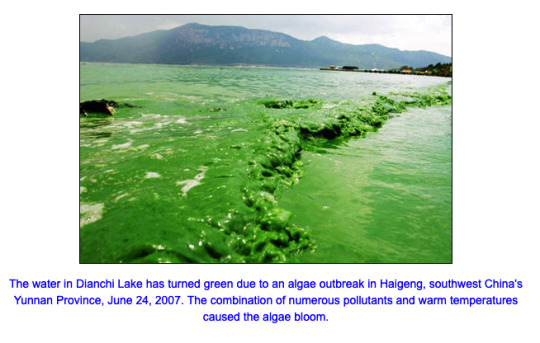
References:
Lucie Guo, "Doing Battle with the Green Monsters of Tai Lake." Science Vol. 307, Issue 5842 (31 August 2007), p. 1156
Pei-yu Catherine Tai and Linda Ellis, "Taihu: Green Wash or Green Clean? " Wilson Center (October 2008)
Richard Stone, "On Lake Taihu, China Moves to Battle Massive Algae Blooms," In Yale Environment 360 (published at the Yale School of the Environment) July 11, 2011
0 notes
Text
Dead Shirts: Beauty of Climate Change #35
The scale is breathtaking. Piles of new clothes in the Atacama Desert can be seen from space: 39,000 tons of unused clothes sit in Chile’s desert.
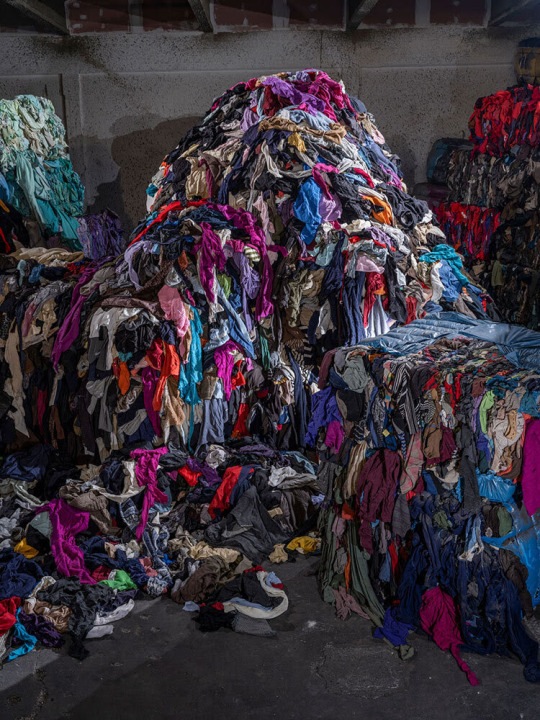
Photograph by Luca Locatelli / Nat Geo Image Collections
Clothing that did not sell in stores in Europe, Asia, and the U.S. arrives from all over the world to Chile’s Iquique Port, 59,000 tons of new clothing annually.
This is where fast fashion goes to die.
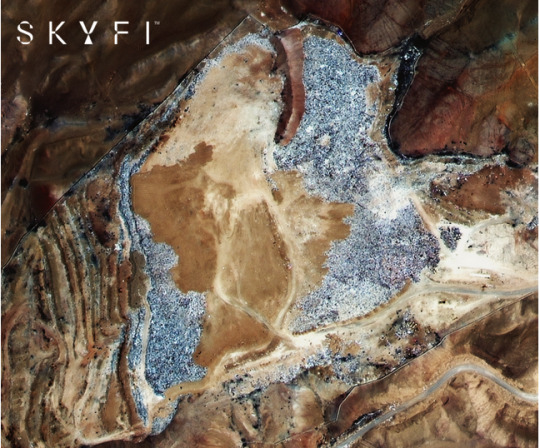
The image, purchased by SKYFI from Discord for $50 US, shows the scope of the textile waste. The dump contains Christmas sweaters and ski boots that were never worn-- items that are polluting the environment.
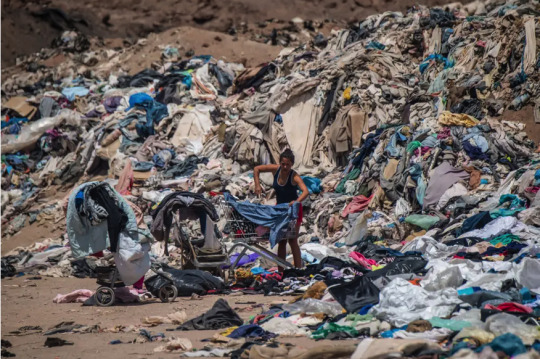
Photo: Martin Bernett/ Getty Images
Residents pick through the clothing to find brand names that they can sell in street markets. Several tons of clothing that arrives in the port is shipped to Venezuala, where it can be sold. The rest remains. Textile waste requires 200 years to break down, and the dyes and synthetic components of shoes, including ski boots, and decorative trim contaminate the environment.
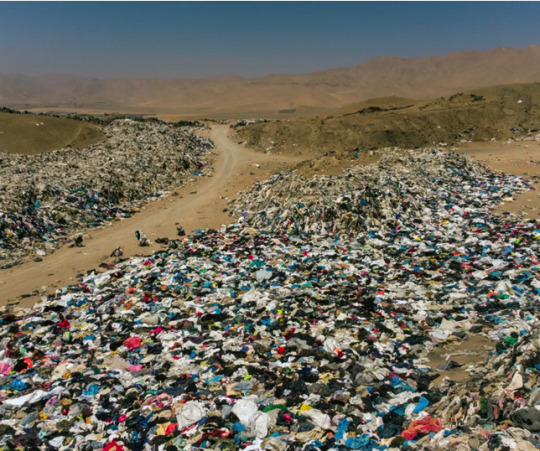
Photo: Martin Bernett/ Agence France Presse
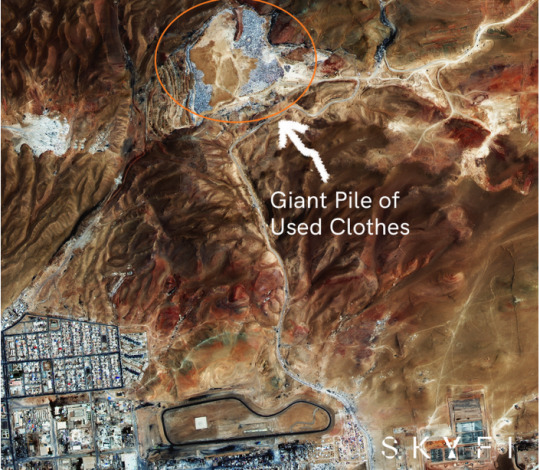
The Atacama Desert climate is among the most arid in the world, so arid that it was used in simulations for moon landings.
Many of the chemicals used in dying textiles are toxic, along with synthetic components of shoes and fabrics. These materials contaminate the environment.
References
1 note
·
View note
Text
Purple Haze: Beauty of Climate Change #34
Plumes of wildfire smoke have traveled from Quebec on Tuesday, June 6 2023.
The haze comes in a variety of colors, and has bathed New York City in gold, grey, yellow, orange, deep blue, and purple before sunset on June 6.

Photo by Carlos Osorio/Reuters
Smoke has the peculiar ability to warp colors, as Dan Delfuoco of Syracuse, N.Y. noticed. “It felt like it was constantly sunset,” starting from 10 a.m. He set off to photograph the perpetual sunset. The smoke gave the sun a brilliant reddish-orange tinge. In Fairport, N.Y., a man reported a light purple sky and a “sickly blood-orange” sun. Ann Schauman, owner of Ann’s Purple Produce in Macedon, N.Y., described the sky as beige and the sun as bright red. She has lived on the land 48 years, and said, “I’ve never seen anything like it out here.”
White light from the sun is made up of all colors in the spectrum. But smoke particles in the air “tend to scatter the shorter wavelengths (that is, bluish light) more than the longer wavelengths (reddish light). Therefore, bluish light from the sun is scattered in a bunch of directions (not into your eyes) while reddish light still gets to your eyes,” according to Kofi Donnelly, who teaches physics at a Brooklyn high school.
New York City air quality is among the worst, measuring 2.5 particulate matter. The level of air pollution in New York City reached 480 by 3 p.m. on Wednesday, June 7, and spiked to 800 that evening. We knew that it would happen.
Haze and particulate matter produced by wildfires in eastern Canada has traveled through the Hudson Valley and now covers an area stretching from Pennsylvania, Massachusetts and New York westward to Minnesota.

A view of the Manhattan skyline from the Hoboken waterfront. Photo by Christopher Alonzo
It’s not a fluke. “All estimates seem to indicate that it’s only going to get worse--that the droughts are lasting longer and we are experiencing higher temperatures,” said Jack Caravanos, a clinical professor of environmental public health sciences at NYU. He spoke with WNYC host Sean Carlson about how citizens can protect themselves.

Photo: Johnny Milano for The New York Times
References:
“How to protect your lungs as NYC’s air quality suffers from wildfires,” by Nsikan Arpan, Elizabeth Shwe and Sean Carlson in The Gothamist, June 7, 2023 6 a.m.
Ken Sturtz and Cole Louison, “The haze comes in a variety of colors--orange, yellow, even purple.” The New York Times, June 6, 2023
1 note
·
View note
Text
Beauty of Climate Change #33 Trash Peaks (Design Earth)
“Trash Peaks” uses a carpet, a tea set, and a folding screen to present waste solutions at the 2017 Seoul Biennale.

The artifacts are a setting for a tea ceremony, where one can discuss waste.
Design Earth project leads Rania Ghosn and El Hadi Jazairy created Trash Peaks. Conceptual Design: Reid Fellenbaum, Victor Lee, Monica Britt Hutton, Beth Savrann.
Concretely: how to transform plastic waste; extract rare earth metals from e-waste in the Yongsan Electronics Market; power a city by burning waste in landfills; build a monument out of construction debris--concrete, steel, and wood; filter organic contaminants in a reclaimed landfill; and retrofit gas pipes for methane--what Monica Hutton calls a “terrarium of the Anthropocene.”

The carpet is an infographics diagram that details specific matter of each site and gives an overview of waste management in Seoul, knitting together the macro- and micro-level of the city.
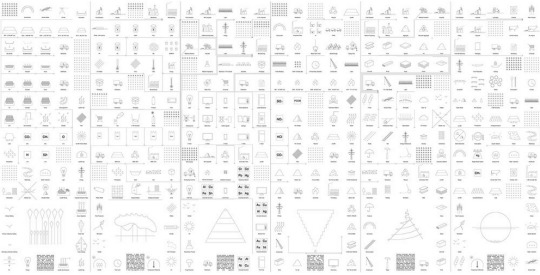
They write: “Trash Peaks proposes six projects that place the matters of waste –its flows, ecologies, and logistics– at the center of urban concerns. The six projects are: 1) Plastisphere, recycles obsolete plastic waste into a plastidome that hovers on top of the Changsin hilltop toy market; 2) E-Fungi Volcano, deploys fungi species over five levels of extraction to mine different rare earth metals from the e-waste stream in the Yongsan Electronics Market; 3) Janus Incinerator, embedded into the Bukhansan Mountain, burns waste from decommissioned landfills to power a quarter of the metropolis’ energy demands; 4) Towering Construction, wraps Seoul’s waste of concrete, steel, and wood around Mount Namsan; 5) Leachate Cenotaph, filters organic contaminant and ammonia concentrations in the reclaimed Sudokwon Landfill, 6) Methane Aviary, retrofits the vertical gas pipes of the excavated Nanjido island into an aviary forest. The installation presents the six projects through the artifacts of carpet, folding screen, and ceramics tableware. The carpet is an infographics diagram about waste management in Seoul and the matters of concern specific to each project and site. The folding screen appropriates the object of the irworobongdo, the symbolic Korean folding screen that portrays a place of peaks in a royal court, to recompose a series of six highly stylized landforms.

Each of the landforms in itself transforms a monument –such as Lequeu’s Temple de la Terre, BEL Architects’ watchtower, Price’s Aviary– to critique the relationship with the natural environment in an era of ecological anxiety.
The ceramics tableware is a set of project miniatures that serve as the setting for a tea ceremony in which participants discuss the concerns of waste management.”
February 16, 2023 in Washington Heights, Manhattan
0 notes
Text
Beauty of Climate Change #32: Plastiglomerate
Plastiglomerate is a hybrid of plastic and stone. The term was coined collaboratively by oceanographer Charles Moore and artist Kelly Jazvac and geologist Patricia Corcoran, who returned to the site where Moore found the hybrid rock in 2006, to collect specimens in 2012.
Plastic might have been the miracle of modern manufacturing. The material improved hygiene in medicine and food storage. It is also a horrific mix of impermanent and permanent. The plastic material is cheap and disposable, but it does not disappear. It breaks down into pieces, then it fragments and binds
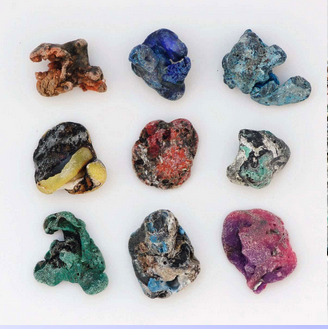
with living matter. Microplastic agglomerates with living matter. Sculptor Kelly Jazvac collected plastiglomerate specimens from Kamilo Beach in Hawai’i.

The artist and geologist found plastic fused with sand, shells, and natural materials. The fusion of man-made and natural material was aided by fire.

Bonfires on the beach sped the process of agglomeration. The flames melted the plastic into horribly wondrous, magical, and toxic forms.

Javzac and Corcoran displayed the plastiglomerates as sculptural objects and scientific artifacts of our geological era, the Anthropocene. Plastiglomerate was the title of an exhibition, curated by Georgia Erger, Curatorial Assistant at the Eli and Edythe Broad Art Museum at Michigan State University.

As Erger writes, “Plastiglomerates visualize the entanglement of human consumption and the environment that must necessarily adapt plastic to itself. These are not-natural, not-functional, magical, poisonous hybrid stones.
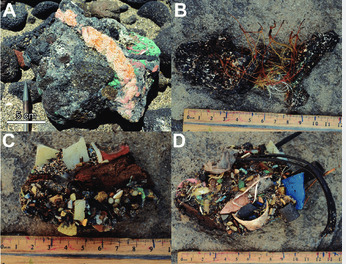
December 20, 2022, Washington Heights, New York
0 notes
Text
The Beauty of Climate Change #31: A Body in Places
A woman in a white linen kimono, with a black silk kimono on top, loosely tied and moving in the wind, moves around a construction site in West Kowloon. The Bank of China tower sits across Victoria harbor, in a sea of steel and glass.


Eiko Otake is a body in a Hong Kong in December 2015. A Body in Places is her first solo work, begun as an extended performance from 2014 to 2019 in irradiated Fukushima. Eiko responded to the Fukushima earthquake, tsunami, and nuclear disaster that left homes, industrial sites, water, and earth irradiated and uninhabited. The Japanese Butoh dancer performed for decades as Eiko of Eiko & Koma, bringing the post-war dance and minimalist, anti-materialist, anti-capitalist forms to the world. Japan is the only nation ever subjected to nuclear attack. Butoh, and Eiko as its expressive face, turned that experience around to witness the effect of violence and destruction around the globe.
At the start, she emerged from a temporary hut, its door facing away from the construction overlooking Victoria Harbor, the channel that divides Hong Kong Island from Kowloon. Then Eiko inched toward the wire link fence on the west edge, and she began to follow the fence with her eyes on the harbor. A construction crane sat idle, its gear dangling high above her head, on the other side of the fence. A digging machine operator was still at work, lowering the bucket of the digger and then raising it to move a medley of stone and dirt from the harbor edge of the site (across the fence) to a large container for debris.

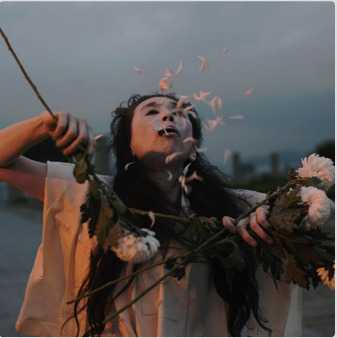
Eiko performed A Body in Hong Kong solo in several venues in the city, each performance responding to the features of the place. Clothed in an off-white kimono, face whitened with clay, and bare legs and bare feet, she is distanced from the audience, bundled up again the winter cold in Hong Kong (a spring-like 50 degrees Fahrenheit).
The minimalist dance forms of Butoh developed in post-war Japan. Some practitioners have spoken of the discipline and the unyielding discipline of students by master dancers. The movements of Butoh seem tortured, slow, apparently erratic. There is repetition and variation, resembling everyday gestures and activities but not everyday. The minimalist gesture, white-painted bodies, scant clothing, and the illegibility of the form is anti-materialist, anti-capitalist.
Japan is the only nation ever subjected to nuclear attack. Butoh, and Eiko as its expressive face, turned that experience around to witness the effect of violence and destruction around the globe. of master Eiko and Koma danced as partners, appearing on stages around the globe until his death in 2001.
Inching around the edges of the construction site in Kowloon, situated on the Chinese mainland, yet 30 miles from the Chinese border, there was no disaster. Eiko used her body to trace the boundaries of a ruin-in-progress. There was, as yet, no disaster in December 2015, only a construction site three years behind schedule. But there had been a series of sit-ins on the main traffic arteries of Hong Kong Island and in Kowloon, from September to December 2014, in the so-called Umbrella Movement. And there would be violence, launched by the government in response to non-violent protests after an Extradition bill was proposed in February 2019, ostensibly to render fugitives from Hong Kong law subject to trial in the territory. There would be violence on both sides of Victoria Harbor.
Beauty of Climate Change #31, completed December 19, 2022 in New York City.
References:
(Re)positioning Dance: Local Sites, Global Issues, ed. Karen Barbour.
Gillian Jakab, A Body in Fukushima,” IN Gagosian Quarterly September 2021 Issue.
0 notes
Text
Clastic Plastic: Beauty of Climate Change #30
It is snowing plastic in the ocean.

A photo of marine snow--material as old as the ocean itself--appeared in The New York Times. Except the microbes that bring dead organisms, plants, and other material to the ocean floor are melded with plastic. Or, let us say, plastic has infiltrated the snow. Marine snow looks like stardust, as I imagine it, gleaming white and shimmering in the watery depths of the sea where fish and plants wait for food to fall to them.
Clastic plastic is our future--fragments of plastic embedded in the sediment at the bottom of the ocean.
Clastic plastic is the unacknowledged present. Plastic has embedded itself in sand and sediment since it came into use in the 1960s. You remember the line in the 1967 film The Graduate: “The future is plastic.” Glass soda bottles were replaced by PET plastic (polyethylene terepthalate after it was patented in 1973; PET keeps drinks carbonized for a longer time at higher quality for lower price. Globally more than a million plastic bottles are sold every single minute, according to the National Geographic. prized because carbonation to make soda bottles, containers, toys, or combs and tools so inexpensive and replaceable that we can throw them away and buy a shiny new comb without a second thought.
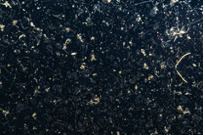
Clast is a fragment of older rock now broken up and embedded What is “clast,” you ask? A clast is a fragment of rock that can be as small in size as one micron or as big as an apartment block. The rock fragment might be broken off other rocks by physical weathering, wind and rain, or by impact. Geologists use the term clastic to refer to sedimentary rocks as well as to particles in sediment transport, which can be suspended there on the way to somewhere else, or deposited in the sediment where it will harden.
The clastic material broken from old rock will become distributed through the sediment of new rock.
Plastic rocks into the picture, and clastic material as small as one micron or less and as large as an inch or a foot (or more) is captured in sediment.
Clastic plastic will rock our future.
Completed April 14, 2022. Ridgewood, Queens.
Laura Gordon, “How the Plastic Bottle Went from Miracle Container to Hated Garbage,” National Geographic August 23, 2019
Sabrina Imbler, “In the Ocean It’s Snowing Microplastics,” The New York Times, April 3, 2022
0 notes
Text
Fluid Standing: Beauty of Climate Change #29
The Colorado River Basin is running dry.
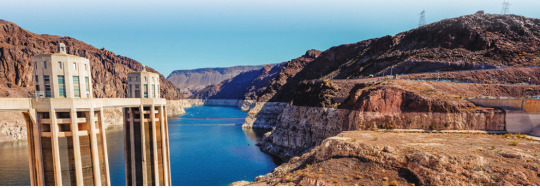
The water table has dropped more than 160 feet since 2016, leaving mineral deposits that look like a bathtub ring. The BLD Efforts to cast an agreement to conserve water were 3 years in the making, and climate change exacerbated the weak measures, creating a water emergency. In December 2021, after three months of discussion, a collaborative plan to hold back an additional 500,000 acre-feet of water annually in Lake Mead was agreed. The 500+ Plan involves fallowing fields that would draw from the river ecosystem through payments to farmers, tribal agreements to not draw water from Lake Means, and economic incentives to limit domestic water use for Arizonans, among other measures.
To save the river system, one approach would grant moral rights to the water. At present, water can be defended only after significant harm is caused, and a next friend can take up the water’s cause. In effect, the water or river can be defended in a third-party injury suit.

Michelle Healy, a law student at the University of California, suggests indigenous people’s view that natural resources such as trees and water deserve the same rights generally reserved for human beings can deter damage to ecosystems. Black’s Law Dictionary defines a legal person as “a being, real or imaginary, who for the purpose of legal reasoning is treated more or less as a human being.” Corporate entities are persons, in the eyes of the law, as we know. Water systems have been granted rights in Ecuador, in 2011, and by the New Zealand Crown Government, in 2012, where they recognized the Whanganui River as a legal entity. The court likened the Whanganui’s personhood to a charitable trust or legal trust which would now have trustees dedicated to protecting its wellbeing.
Michelle N. Healy (2019), “Fluid Standing: Incorporating the Indigenous Rights of Nature Concept into Collaborative Management of the Colorado River Ecosystem, Colorado Natural Resources, Energy, and Environmental Law Review, Volume 30: 2, pp. 327-60.
Kaleem, Jalid and Ian Rice, “California, Arizona, and Nevada agree to Take Less Water from ailing Colorado River,” Los Angeles Times, December 15, 2021.
Timothy Lange (Signed Meteor Blades), “Earth Matters: Colorado River Disaster Affects Millions,” Daily Kos, January 6, 2022.
0 notes
Text
Who needs a door when the wind blows? Beauty of climate change #28
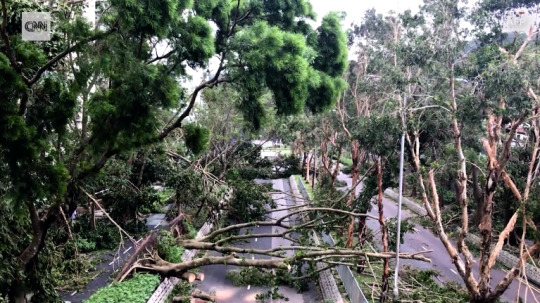
The world’s fiercest storm hit Hong Kong, the Philippines, Macau and South China on September 16, 2018. The super typhoon was named Mangkhut (Shanzhu in Chinese). Named for a mangosteen, a fruit with a dark brown outer husk protecting soft, white fruit, which peels away like a tangerine.
The typhoon tore roofs from houses. In Macau, building facades were blown from the structures. One man sleeping on the front porch leapt from his bed as it tipped over from the apartment into the street. The storm destroyed the collection of rare manuscripts deposited by Jesuit missionaries in Macau, a former colony of Portugal.
Who can shut the door when the wind blows hard? 107 miles per hour winds in Hong Kong toppled swathes of trees, and those trees crushed buses, mashed iron fences. The trees wept with all that they had, although no people died.
December 23, 2021, Chelsea District, New York City

0 notes
Text
Hiding in plain sight: Beauty of climate change #27

Image: Hiding in the vineyards with the master of Ruinart, 2018
Liu Bolin is a performance artist, photographer, invisible man, and climate activist. He was invited to Ruinart, the first established Champagne house, to make a series of images to reveal the production process and tradition of the company, in Rheims, Southern France, over a ten-day residency.
Liu paints himself from head to toe so that he fades into his environment. This process of camouflage has launched ad campaigns for Monclair active wear. He has also faded into the manuscripts and books in the Americana section at Argosy Book Store in midtown Manhattan. Abraham Lincoln’s signed portrait hid his torso, while leather-bound titles of American classics tattoo his face.
“The process of transforming from visible to invisible” is fascinating, he explained. “(It) can be read on many levels. I would like the viewer to relate this process to their own survival, their life status, and see that this is a reflection of their own life.
As a tribute to Ruinart’s history of support for artists, Liu Bolin dissolved into a poster by Alphonse Mucha done in 1896; the color lithograph was one of his earliest commissions for F. Champenois (173 x 59 cm, 68 x 23 1/4 inches). He enters into the heritage of industrial patronage for the arts, quite literally. The strategies for becoming invisible explore the interfaces between man and machine; nature and industry; green plants and humans.

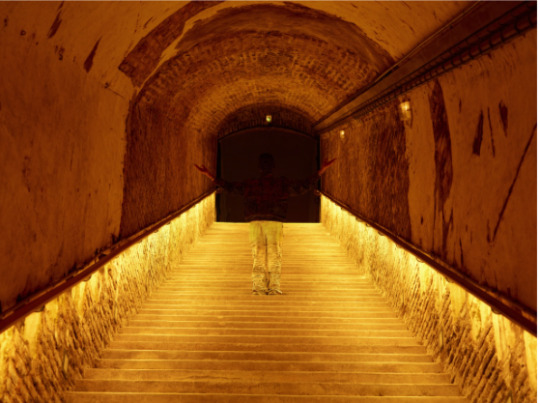

Disgorgement production line with workers, 2018
One space Liu Bolin discovered (or “covered himself in”) links the outdoors to the cellar. Standing at this point, you can see the vineyard, while standing on the sloped passage into the vault where Champagne is aged. His outstretched arms extend beyond the arc of the entrance; his trousers brushed in gold blend in to the lighting on the stairway. His upper body is a pattern of shadows fallen beneath the leaves on the vine in darkness.
Liu Bolin also visited the equipment for manufacturing champagne. The artist said the expertise, enthusiasm, and passion of the team for the product impressed him deeply. “I knew I had to include them.” Their legs are the grey of the concrete floor; their core and shoulders follow the pattern of the production line’s steel “U” and their faces are the ghostly white of the air illuminated by neon overhead lighting.
Liu began his career doing experimental sculpture. An opportunity to share his work on television to explain how he combines sculpture with behavioral thinking introduced the possibility of amplifying his art through social media. Liu Bolin has been involved in advertising campaigns for Moncler, for whom he dissolves into a landscape. For the Fall 2017 Moncler campaign, he disappeared in an iceberg. (You can find a link to a videoclip below)
(in 2015), Liu Bolin said, “I presented a live broadcast through my cell phone about the contaminated fog condition in China. In the future, I’d like to perform another live broadcast through cell phones or cell phone software for something I believe is worthwhile—and continue questioning certain issues in humanity.
Notes:
Fall 2017 Moncler campaign:
https://wwd.com/fashion-news/fashion-scoops/liu-bolin-disappears-iceberg-moncler-fall-2017-ads-10942253/
May 19-26, 2021 Chelsea District, New York, NY 10011
0 notes
Text
Rocking the end of the world: Beauty of climate change #26
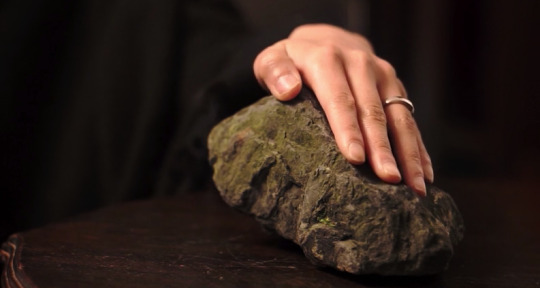
I’m curious whether the planet itself can sense the shifting balance of life? At this moment--over the past three decades--animals, birds, bees, snakes, frogs and more become extinct at a growing pace.
Have you ever wondered if the earth, stones, and water that fills our oceans and lakes, rivers and wells can sense the balance of living things?
Does a rock have “being”? One test is whether a stone emits electricity. Do rocks emit electromagnetic waves? Can those waves be construed as “being” ? Of course, rocks exist, and so they have “being.” What do rocks rock? How does a rock rock.
A report on electromagnetic activity in stone appeared in the Proceedings of the VIIth International Electric Activity Conference in 1985.
Toshio Ogawa Kazuo Oike Taiji Miura composed an “Abstract” :
To test the possibility of the emission of electromagnetic waves from rocks, experiments have been made to measure the electric field by using mainly granite samples that were struck together or struck by a hammer or a weight and were fractured by a bending moment. The wide‐band (10 Hz to 100 kHz) waveforms of electric signals were digitally recorded. Roughly four kinds of signals have been observed: 30 kHz, 5 kHz, 10 Hz and, in addition, intermittent pulses. Using these measurements of the electric fields, the average electric dipole moment generated was estimated to be 10−14 C m. The possibilities of producing such a dipole moment are discussed in terms of contact electrification (or separating electrification) and piezoelectrification, and both possibilities are shown.
Don’t rocks have something to say to us? More, at least, than a waveform generated in response to being struck with a hammer, or a weight?
If rocks have “character” and “use,” or personality, then might they not have a pulse or flow of life?
Tuesday, May 28 2019, Smithfield Road, Kennedy Town, Hong Kong
References:
Marysia Lewandowska, “Rehearsing the Museum” Film @2015 Creative Commons. Still photo of a moss covered rock.
Toshio Ogawa Kazuo Oike Taiji Miura, “Electromagnetic Radiations from Rocks,” JGR Atmospheres, Vol. 90, Issue D4, 30 June 1985. Pages 6245-6249

0 notes
Text
Playing in a desert: Beauty of climate change #25

A white deer grazing beside a power plant in Inner Mongolia (2011) and two people snapping portraits on an eroding island that erupts from a tributary of the Yellow River (2010).
These unearthly scenes are two of many such images captured by Zhang Kechun (b. 1980). He spent four years photographing the Yellow River with a large-format camera. The Yellow River is known both as the cradle of Chinese civilization and China’s sorrow. For millennia, the river periodically flooded, devastating the land along its banks.
Zhang Kechun discovered that “the river which once was full of legends had gone and disappeared (1). Suzanne Labarre reviewed his poetic photo essay titled _The Yellow River_ (2012), describing its contents as un-lovely factories, half-built bridges, and high rises.
The photographs also show the eery beauty of the region and its inhabitants, capturing the rhythms of work and play.
Many of his photographs are elegant colourscapes. Even while the mind knows this is the yellow of arid soil, soil without water, grass without hope of growing back again, he using this palette of drought and thirst to beautiful effect.
La Galerie Paris 1839 in Hong Kong represents the photographer, thanks to the curatorial vision of Marie Florence Gros and Cyril Delettre.
(1) https://www.fastcompany.com/1669242/a-poetic-photo-essay-on-the-death-of-chinas-yellow-river
(2) About Zhang Kechun, on the home page of La Galerie Paris 1839 (physically located in Hong Kong) https://www.lagalerie.hk/home#/zhangkechun/
0 notes
Text
Safe harbour: Beauty of Climate Change #24

Laleh Khallili is writing a book about the maritime coastline in the Arabian Peninsula. The Sinews of War and Trade examines the built structures and politics of the coastline.
Khalilli will reflect on the processes of harbor-making that transform coasts, seashores, subsea contours, and the very shape and flow of the seas. Such transformations harm ecosystems near and far. For instance they entail sand-mining, concrete manufacture, and production of aggregates: sand is the most traded world commodity by volume, while the production of one ton of Portland cement produces around one ton of CO2. Harbors also influence social lives in ways that subtly play havoc with the environment in the long run. She gives an Intra-Disciplinary Seminar at The Cooper Union on 25 September 2018, and will specifically focus on the ports of the Persian Gulf, one of the shallowest seas in the world, and home to a variety of warm-water marine flora and fauna.
0 notes
Text
When the sea turns dry: Beauty of climate change #23

“An enormous blue void at the north end of the Imperial Valley, the Salton Sea once attracted more visitors than Yosemite.” Residents suffer from asthma at alarmingly high rates. Michael Zelenko writes of Michelle Dugan, a 27-year-old, who has been told by doctors she has the lungs of an 80-year-old. Her younger sister died from an asthma attack that could not be eased by inhalers, and choked on her own saliva.
Between our constant thirst, irrigation, and global warming, water tables are falling gradually. Inland lakes like the Salton Sea, which have no drain, are especially vulnerable.
The Salton Sea has been shrinking for decades, but took a nose dive on January 1, 2018, when an agreement with the City of San Diego caused 40 percent less water to flow into the sea. The sea bed produced thin clouds of white dust, which invade the air, and sends plumes of sulfurous dust into the air that drifts toward Los Angeles.
The sea bed is a fine powder composed of dust, dried fish bones, beautiful detritus with deadly consequences.
Michael Zelenko, “Dust Rising: As California’s largest inland lake dries up, it threatens nearby communities with toxic dust.” The Verge, June 6 2018
https://www.theverge.com/2018/6/6/17433294/salton-sea-crisis-drying-up-asthma-toxic-dust-pictures
0 notes
Text
Beauty of Climate Change #22 Undoing the aesthetic of ruin
Agnes Denes, Tree Mountain

Participating in an exhibition of land and earth sculptures in Sittard, Netherlands, Tree Mountain is a massive earthwork and reclamation project constructed on the site of an abandoned gravel quarry in Finland.
Denes completed “Tree Mountain — A Living Time Capsule” in 1996. The project involved volunteers from different countries, of 11,000 Finnish Pine trees in an intricate pattern. The volunteers were then each given inheritable certificates (valid for 400 years) which granted them responsibility for the stewardship of one of the trees. This project was first announced by the Government of Finland at the World Summit in Rio de Janeiro as a contribution to global ecology-pla required ten years to progress from seedlings to a mountain of trees. Zero 1/ Green Museum
Time is an element. Human stewardship also important.
Maths is also an ingredient. Sun, the fourth.
Ecovention Europe , exhibition, 03/09/2017-07/01/2018. Museum Hedendaagse Kunst De Domijnen, Sittard, Netherlands Major exhibition of Land Art & Ecological Art 1957 - 2017 Curated by Sue Spaid
0 notes
Text
Fire Season 2017: The Beauty of Climate Change#21

In September 2017, wildfires destroyed much of Napa Valley in Northern California. People who had rented vacation homes perished, when trying to shelter in swimming pools, and long-time residents in the mountains died in their cars.
Does the severity of the wildfires have anything to do with climate change? Absolutely, yes.
0 notes